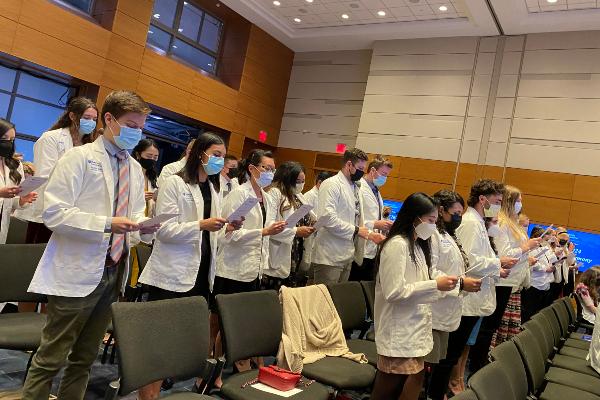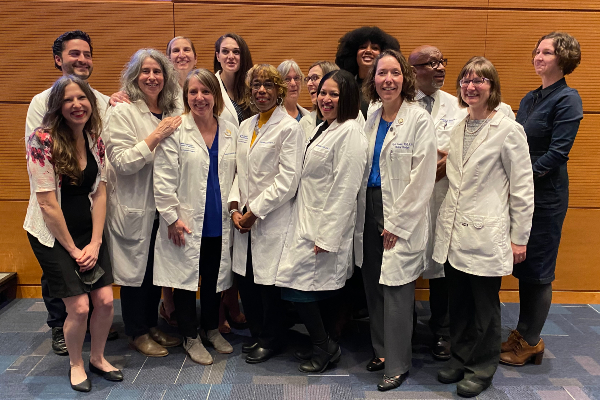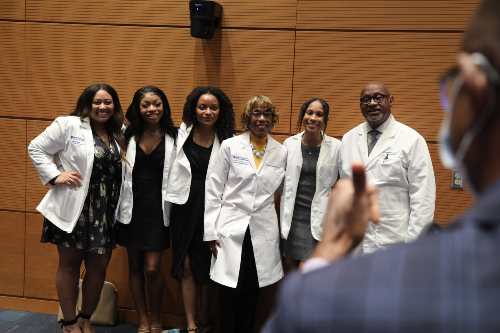PA Students Don Their White Coats

The Duke Physician Assistant (PA) Program held its traditional white coat ceremony for first-year students on January 4, 2023.
For the first time since 2019, the entire first-year class gathered in one location to celebrate their journey into PA education.
Usually held on the first week of school in the main Duke PA Program classroom, this year’s ceremony was postponed until the new calendar year, a move many students appreciated, saying it made the evening more meaningful to celebrate after getting to know their classmates. Transitioning to the Great Hall in the Mary Duke Biddle Trent Semans Center for Health Education allowed students to invite guests to the ceremony for the first time in many years.
The History and Symbolism of the White Coat

Division Chief and Program Director Jacqui Barnett, DHSc, MSHS, PA-C, started the ceremony by sharing the history of the white coat.
She explained that, until the late 19th century, physicians actually wore a more somber black attire, as medical care was frequently a last resort and rarely had positive outcomes for patients.
The trajectory that led doctors from black garb to white coats closely followed the incorporation of science into medicine through the end of the 19th century and into the 20th.
Barnett said that, as medicine advanced and took a more scientific course, the white coat became the “preferred color of lab coats and doctors’ uniforms because it symbolized cleanliness, purity, righteousness, it did not fade when washed at high germ-killing temperatures, and any soiling of the coat was easily noticed.”
By the 1920s the white coat was firmly in place as “a powerful and iconic symbol of the physician as the medical scientist,” said Barnett.
The first white coat ceremony was held at the University of Chicago in 1989 after a professor complained to the dean of students that the first-year medical students were showing up in shorts and baseball caps. The first symbolic use of the white coat ceremony was at the Columbia University College of Physicians and Surgeons in New York in 1993.
Today, the white coat ceremony is a common tradition across all health professional programs.
Privilege and Responsibility
The white coat, Barnett said, “is a powerful symbol that can be used or abused.”
Describing the importance and symbolism of the white coat, Barnett told the students, “I want you to understand the privilege of wearing this white coat. Your white coat will suggest to patients that you can be trusted. Your white coat will give patients a sense of hope, guidance, and compassion.”
She emphasized that the white coat confers a profound responsibility on those who wear it.
“Your patients will share information with you that they may not share with their own mothers, fathers, husbands, or wives, and entrust you with their bodies in ways that no one else in society is permitted, because you’re wearing this white coat,” she said. “Honor this privilege by serving them with all of your might.”

Key Challenges
Assistant Professor Nick Hudak, PhD, Mpa, Msed, PA-C, reminded students of the importance of professionalism, both while wearing the white coat and in their day-to-day lives.
“Each of you has a unique and high level of professionalism that you have brought to our community,” Hudak said.
Looking forward, Hudak provided a list of key challenges for students as they set their bar for professionalism.
- Make the most of every learning opportunity.
- Be receptive to both positive and constructive feedback — and seek it out.
- Follow the rules and the recommendations from your programs, your practices, and your clinical learning environments.
- Be someone who responds rather than reacts.
- Always consider how your actions will be perceived and felt by those around you.
- Be kinder than what you think is necessary.
- Be open-minded in mind and in heart when encountering difference, and be inclusive of all.
- Take care of yourself and each other.
- Remember, the sum of all of this talk of professionalism is to ultimately serve our patients and our communities.
Celebrating the Class of 2024
White coat highlights and interviews video by Jim Rogalski
Assistant Professor Megan Holmes, PhD, read the name of each student as their advisor helped them into their coats for the first time, followed by handshakes and hugs with their advisors and with each other.
With the class wearing their new white coats, Assistant Professor Janelle Bludorn, MS, PA-C, led the students and other health care providers in the room in a recitation of the Student Academy of the American Academy of Physician Assistants (SAAAPA) Oath.
Closing out the ceremony, Medical Instructor Jacquetta Melvin, MPH, PA-C, invited all the students to turn and face the live stream cameras and acknowledge the family and friends who helped them in their journey to PA school.

“As you reflect on this occasion, remember your ‘why’. Remember why you embarked on this journey to not only become a PA, but a Duke PA,” Melvin said. “Allow your ‘why’ to guide you as your responsibilities grow and evolve from learning in the classroom setting, to now learning in hospitals and clinics from health care professionals, but most importantly, learning from your patients.
“To the class of 2024, I enthusiastically welcome you into the PA profession — a profession birthed right here at Duke University over 57 years ago. The 91 of you are a continuum of the vision, mission, values, and goals of the Duke PA Program. And the impact you make on your communities will be mighty and significant.”